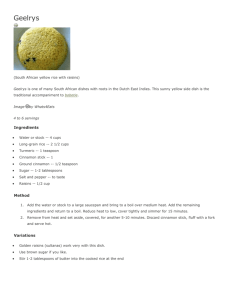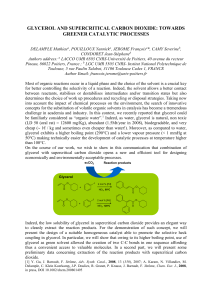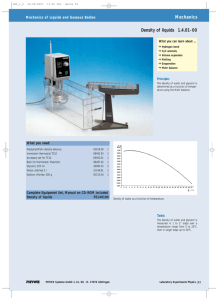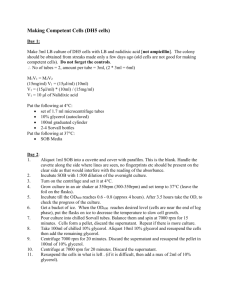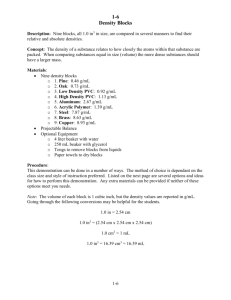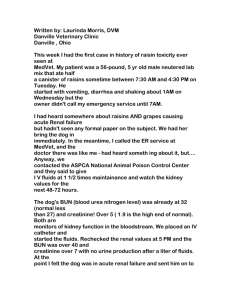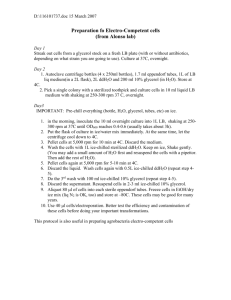Density - The Young Scientist Program
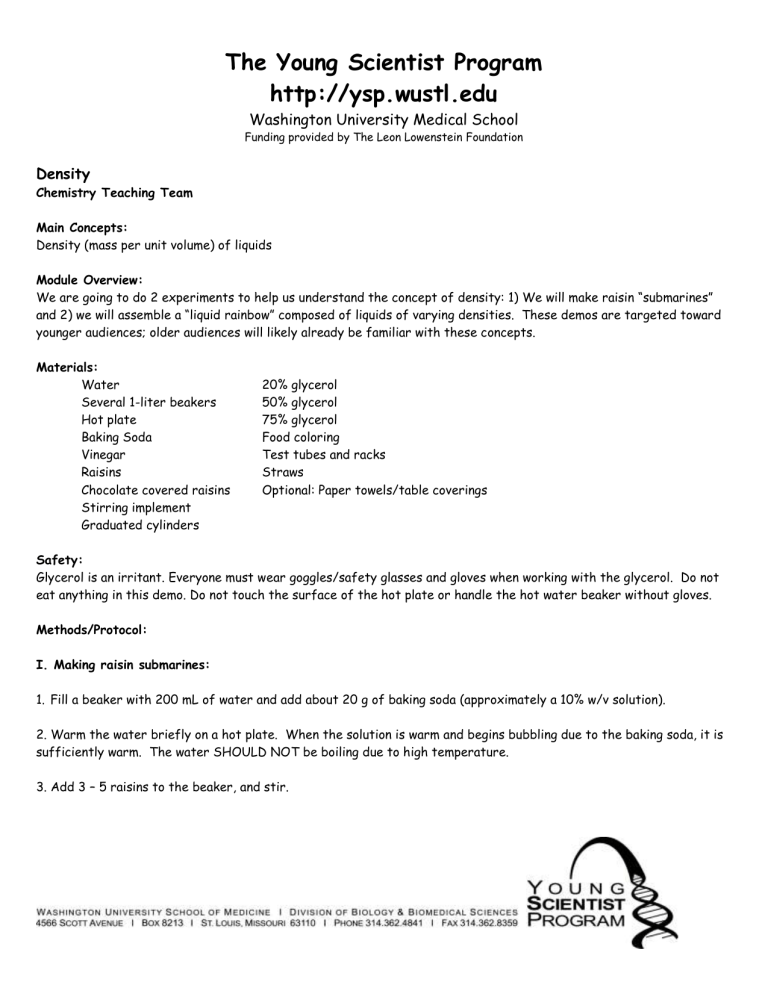
The Young Scientist Program http://ysp.wustl.edu
Washington University Medical School
Funding provided by The Leon Lowenstein Foundation
Density
Chemistry Teaching Team
Main Concepts:
Density (mass per unit volume) of liquids
Module Overview:
We are going to do 2 experiments to help us understand the concept of density: 1) We will make raisin “submarines” and 2) we will assemble a “liquid rainbow” composed of liquids of varying densities. These demos are targeted toward younger audiences; older audiences will likely already be familiar with these concepts.
Materials:
Water
Several 1-liter beakers
Hot plate
Baking Soda
Vinegar
Raisins
20% glycerol
50% glycerol
75% glycerol
Food coloring
Test tubes and racks
Straws
Chocolate covered raisins
Stirring implement
Graduated cylinders
Optional: Paper towels/table coverings
Safety:
Glycerol is an irritant. Everyone must wear goggles/safety glasses and gloves when working with the glycerol. Do not eat anything in this demo. Do not touch the surface of the hot plate or handle the hot water beaker without gloves.
Methods/Protocol:
I. Making raisin submarines:
1. Fill a beaker with 200 mL of water and add about 20 g of baking soda (approximately a 10% w/v solution).
2. Warm the water briefly on a hot plate. When the solution is warm and begins bubbling due to the baking soda, it is sufficiently warm. The water SHOULD NOT be boiling due to high temperature.
3. Add 3 – 5 raisins to the beaker, and stir.
The Young Scientist Program http://ysp.wustl.edu
Washington University Medical School
Funding provided by The Leon Lowenstein Foundation
4. Add vinegar slowly to the solution, it should begin to bubble more strongly. Keep adding vinegar until the raisins begin to rise and fall on their own.
5. Add in chocolate covered (the important part is that they be coated with something). These should rise and fall occasionally, but they should do so less than the normal raisins.
6. Ask the students why the raisins rise and fall. Ask them what they think the difference is.
ANSWER: The raisins rise and fall because the gas bubbles (it’s CO
2
) collect on the raisins. This effectively makes the raisins less dense than the surrounding water. The difference in density generates an upward force that causes the raisins to rise. Once at the top they lose the bubbles and their density increases, causing them to sink. This places them near the bubbles again and the cycle continues.
ANSWER: The coated raisins also collect bubbles. However, the amount of “friction” the bubbles have on these raisins is less than that on the normal, bumpy raisins. I believe that the source of this “friction” is related to the surface tension of the water.
GOAL: The students will be able describe why bubbles make the raisins float.
II. The Liquid Rainbow
1. Add food coloring to the 20% glycerol (red), 50% glycerol (yellow), and 75% glycerol (blue) solutions.
IF THIS IS A YOUNG AUDIENCE: be sure to cover the tables, this demo can be a bit messy.
2. Use a straw with your finger capped at the top to transfer some of each solution to a test tube. You must figure out the right order to add the solutions to make a “liquid rainbow”. The correct order is blue, yellow, red. This will form an actual rainbow of red, orange, yellow, green, and blue (top to bottom).
The separation of colors occurs because of the different densities of the glycerol solutions. If the second liquid is less dense than the first, the second liquid will float on top and two distinct colors will be visible. If the second liquid is denser than the first, the two liquids will mix.
IF THIS IS A YOUNG AUDIENCE: be willing to help them make the rainbow. Often they will just want to mix colors.
In this case, just try to teach what you can.
OPTIONAL: Quantify the Density Differences
The differences in density become apparent with sufficient volumes of the different solutions. Since this will not be appropriate for all audiences, especially younger ones, it is optional.
The Young Scientist Program http://ysp.wustl.edu
Washington University Medical School
Funding provided by The Leon Lowenstein Foundation
1. Make equal volumes of the solutions. A convenient volume that works is 50 mL (see below).
2. Have the students apply what they have learned about density by predicting which solution weighs more based on making the rainbow.
3. Measure the volumes on the balance. Go in the order predicted by the students.
4. Discuss the results of the student predictions.
If it is not possible to do this during the demonstration, here is some data collected while troubleshooting this demonstration:
Dry Tube 13.3 g
50 mL Water
20% Glycerol (RED)
50% Glycerol (YELLOW)
75% Glycerol (BLUE)
63.0 g (Water = 49.7 g)
65.6 g (Mix = 52.3 g)
69.7 g (Mix = 56.4 g)
73.1 g (Mix = 59.8 g)
100% Glycerol 75.4 g (Glycerol = 62.1 g)
Total volume: 50 mL
Density of water: 1 g/mL
Density of glycerol: 1.26 g/mL
Discussion Questions:
3. What is density of an object?
Density is the mass (the amount of stuff) per unit volume.
2. Why do objects float?
Objects float because they are less dense than the fluid that surrounds them. This means that they weigh less than the volume of fluid that they displace. The result is an upward force acting on the object, causing it to float. More simply, an object floats because it is “lighter” than the fluid it is submerged in (generally water).

